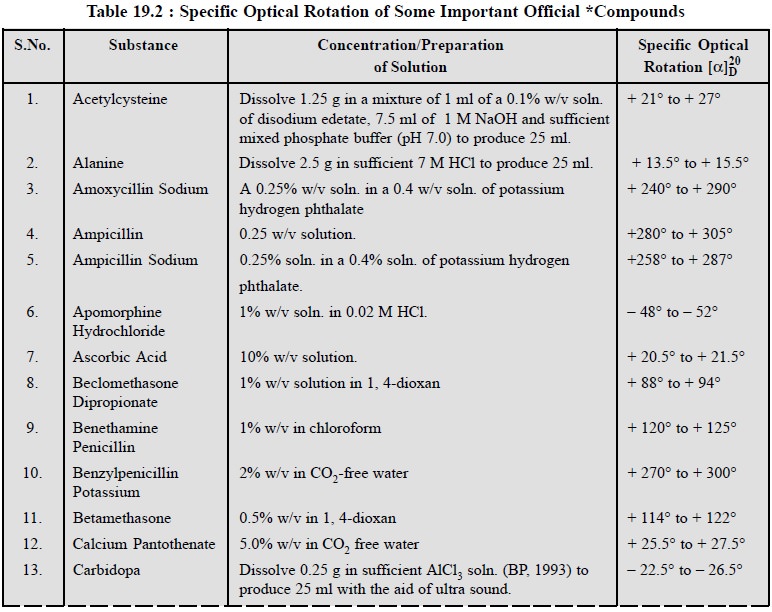Chapter: Pharmaceutical Drug Analysis: Polarimetry
Determination of Optical Activity of Pharmaceutical Substances
DETERMINATION OF OPTICAL ACTIVITY OF PHARMACEUTICAL SUBSTANCES
The two characteristic parameters related to optical
activity of the pharmaceutical substances, namely : (a) optical rotation, and (b)
specific optical rotation, can be measured satisfactorily by the help of a
Polarimeter as stated below :
1. DETERMINATION OF OPTICAL ROTATION OF PHARMACEUTICAL SUBSTANCES
The optical rotation of a number of pure pharmaceutical
substances may be measured accurately by noting the angle through which the
plane of polarization is rotated when polarized light passes through the
substance, if liquid or through a solution of the substance, if solid.
A few typical examples of ibuprofen and levodopa are
discussed below :
1.1. Ibuprofen
Materials Required : 2.5% (w/v) solution of
ibuprofen and a polarimeter ;
Procedure : First and foremost it is
absolutely necessary to check the linearity of the scale of a polarimeter either using certified quartz plates or using known solution of sucrose.
The sample tube of the polarimeter is rinsed with the
drug solution (2.5% w/v) and filled up with the same solution. The end
glass-windows are closed properly. The angle of rotation of ibuprofen is now meas-ured
at 19.5° to 20.5°, using the D-line of polarized sodium light. Take at least
five measurements and determine the mean value.
1.2. Levodopa
Theory : It has been observed that the
specific rotation of levodopa in the visible region is rather on the lower side i.e., ([α]20D = – 12° in 1 M hydrochloric
acid). Therefore, it is necessary to enhance the optical rotation to a
reasonable extent by some suitable means. It is, however, achieved by the
formation of a com-plex with hexamine.
Materials Required : Dried levodopa : 0.2 g ; hexamine : 5.0 g ; hydrochloric acid (1 M) : 50 ml (dissolve 85 ml of HCl in 1 L of DW) ;
Procedure : Dissolve a quantity equivalent
of 0.2 g of the dried substance
and 5 g of hexamine in 10 ml of 1 M hydrochloric acid, add
sufficient 1 M HCl to produce 25 ml and allow to stand for 3 hours, protected
from light. The optical rotation is measured by a previously calibrated
polarimeter.
Optical Rotation : – 1.27° to – 1.34°
1.3 Cognate Assays
The optical rotation of a number of substances official
in the pharmacopoeia may be determined con-veniently as stated in Table 19.1.

2. DETERMINATION OF SPECIFIC OPTICAL ROTATION OF PHARMACEUTICAL SUB-STANCES
The specific
optical rotation of a solid substance is usually determined by measuring
the angle of rotation at the wavelength of the sodium D-line at a temperature
of 20°C, and calculating the result with reference to a layer 1 dm thick of a
solution containing 1 g of the
substance per ml. It is pertinent to mention here that the specific optical
rotation of a solid is always expressed to a given solvent and concentration.
Example : Adrenaline ;
2.1. Adrenaline
Theory : As pure adrenaline is
sparingly soluble in distilled water, therefore, its solution is made in 1 M hydrochloric acid whereby the
N-atom gets protonated and results into the formation of a quaternary ammonium
compounds as shown in under :

Materials Required : 4% w/v solution of adrenaline
in 1 M HCl (dissolve 85.0 ml of HCl in 1 L of DW) ;
Procedure : Determine the angle of
rotation of the freshly prepared 4% w/v solution of adrenaline in 1 M hydrochloric acid with the help of
a previously checked polarimeter. The mean value of at least five similar
determinations is employed in the calculation of the specific optical rotation.
Calculations : Calculate the specific optical
rotation using the following expression, namely :

where, l = the length in dm of
the polarimeter tube,
d = the relative density of the
substance, and
c = the concentration of the
substance expressed as a percentage w/v.
2.2. Cognate Assays
The specific optical rotation of a large number of potent
pharmaceutical substances may be determined by the above mentioned procedure
but specific concentrations and method of preparation of solutions is
accord-ing to the official compendium
as stated in Table 19.2 below :


Related Topics